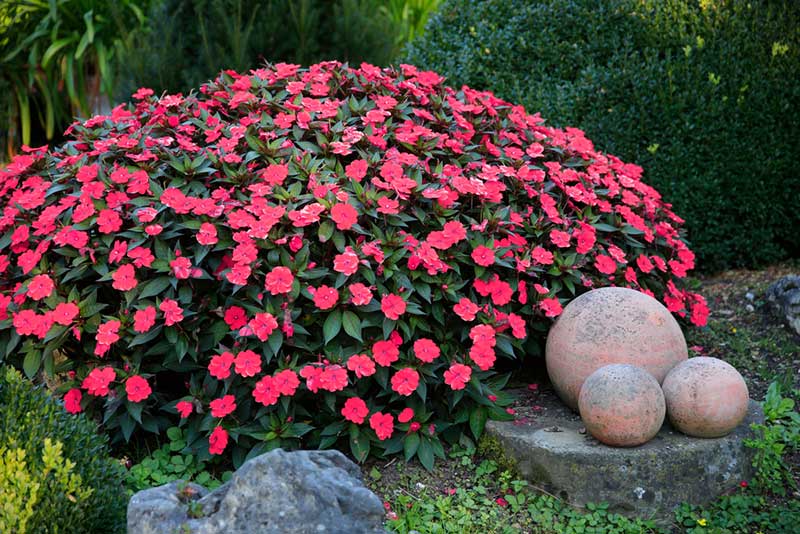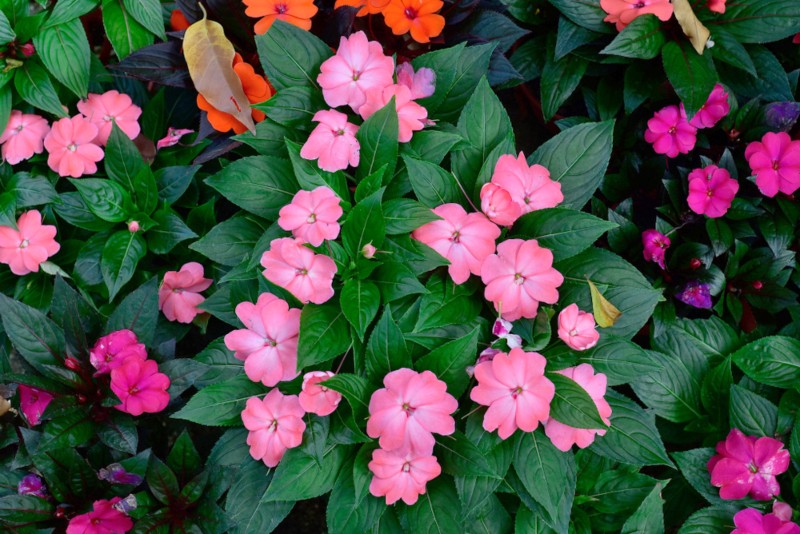
A bright, cheery flower that is easy to grow, impatiens are a mainstay of the household garden. These showstoppers bloom stunningly in shades of pink, purple, coral, white, violet, fuchsia, and red. These beautiful annual flowers are nicknamed “Touch-Me-Nots” because of the way that their ripe seedpods shoot out a burst of seeds even with the slightest touch.
They are very attractive and make wonderful border plants, bedding flowers, or container flowers. Impatiens are lovers of moisture and modest shade. They are most commonly purchased from a garden center and planted into the ground after they have already flowered.
The closer impatiens are clustered together when planting in the garden, the faster they will grow, and the taller the plants will grow. They typically grow between 6-30 inches in height when planted very closely. To gain height, they should be planted just 2-3 inches apart. For flower beds, impatiens should be planted 8-12 inches apart, keeping them low to the ground.
Planting them close together will create a lovely, colorful bank of blooming impatiens. Their blooms are about 3 inches and burst out from yellow-green foliage.
Light and Temperature Requirements for Impatiens
Impatiens are quite hardy flowers. They can thrive in sunlight and moderate heat but grow best in areas of the garden that receive partial shade to a mostly shady space. However, they also enjoy partial shade during the day. Their bloom season typically runs from early summer into very early fall.
Impatiens enjoy the modest shade and need moisture. They are highly popular because they grow well in hardiness zones 2 through 8, making them perfect for gardens in the majority of areas in North America.
The ideal average temperature for impatiens is around 65-75 degrees, taking in the advantage of cooler temperatures when they are planted with a moderate amount of shade.

Water and Soil Needs for Impatiens
Impatiens are highly sensitive to water and a lack of water, even for a brief period, can cause them to wilt rapidly. If they are purchased already rooted from a garden center, make sure that they are amply watered until the moment they are planted into the garden.
Once the impatiens are planted in the garden or flower pot, they should get about 2 inches of water weekly, with that number doubling when temperatures rise above 85 degrees. Typically, garden impatiens will receive enough water from average rainfall in most hardiness zones.
Impatiens planted in containers should be watered daily, with watering twice a day recommended when temperatures rise above 85 degrees on a daily average.
Fertilizer
Impatiens thrive when they are fertilized regularly in the garden or a flowerpot. These bright flowers will thrive throughout the spring and into late summer when they receive water-soluble fertilizer or through a slow-release process done at the beginning of the planting season and then again during the peak weeks of summer.

How to Properly Propagate Impatiens through Rooting the Cuttings
Impatiens are loved by gardeners for their near-effortless growth and the bright, cheerful color they bring to any garden. They look lovely in containers, window boxes, and in the garden bed, making them an ideal plant to propagate to add even more of them to your garden in just a few simple steps.
Impatiens are easily propagated through simple rooting methods. All you need to do is select several non-flowering impatiens steps and cut them to be between 3-6 inches. These cuttings should be done on the stems that have not don’t contain flowers but have at least two leaf nodes. Cuts should be made directly below the node closest to the root.
After cutting the impatiens stems, simply insert them into pots or trays filled with damp potting soil that has several holes dig in it the size of a finger or a pen. These should be watered frequently and placed in an area that receives a good amount of indirect sunlight.
Another way to propagate impatiens is to place them directly into the garden. This should be done in a small, partially shaded location. If placed in the garden, impatiens won’t take root until up to a month. After they have taken root in the garden or a planting pot they can be transferred to their desired permanent location.





